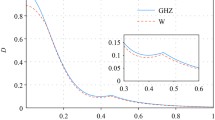Abstract
Mathematical formulation of Bohr’s complementarity principle leads to the concepts of mutually unbiased bases in Hilbert spaces and complementary quantum observables. In this paper, we consider algebraic structures associated with these concepts and their applications to constructive quantum mechanics. We also briefly discuss some computer-algebraic approaches to the problems under consideration and propose an algorithm for solving one of them.
Similar content being viewed by others
Notes
It is assumed that variations of the complementarity principle are applicable in various fields where, for the sake of completeness of description, different mutually incompatible means are used. For instance, paper [1] overviews the application of the complementarity principle in biology, psychology, and social sciences.
The need for at least two different bases (coordinate systems) to describe physical reality is a sort of manifestation of the complementarity principle.
It should be noted that cyclic permutations are the simplest components into which any permutation is decomposed.
Operator A is called normal if it commutes with its adjoint: AA* = A*A.
The common Clifford algebra, which is defined by decomposition of a given quadratic form in an n-dimensional space into a product of linear factors, corresponds to the case of square roots of unity, i.e., ωij = –1 and relations (4.6) take form eiej = –ejei.
't Hooft uses the term “ontic” as an abbreviation for “ontological.”
We use this term because the eigenvalues of operator \(\mathcal{X}\) are frequency exponents proportional to energies in accordance with the Planck formula E = hν, which is valid for periodic processes of any nature.
A clique is a complete subgraph of an undirected graph that is not contained in a larger complete subgraph.
REFERENCES
Pattee, H.H., The complementarity principle in biological and social structures, J. Soc. Biol. Struct., 1978, vol. 1, no. 2, pp. 191–200. https://doi.org/10.1016/S0140-1750(78)80007-4
Schwinger, J., Unitary operator bases, Proc. Natl. Acad. Sci. U. S. A., 1960, vol. 46, no. 4, pp. 570–579. https://doi.org/10.1073/pnas.46.4.570
Wootters, W.K. and Fields, B.D., Optimal state-determination by mutually unbiased measurements, Ann. Phys., 1989, vol. 191, no. 2, pp. 363–381.
Kornyak, V.V., Quantum models based on finite groups, J. Phys.: Conf. Ser., 2018, vol. 965, p. 012023. https://doi.org/10.1088/1742-6596/965/1/012023
Kornyak, V.V., Modeling quantum behavior in the framework of permutation groups, EPJ Web Conf., 2018, vol. 173, p. 01007. https://doi.org/10.1051/epjconf/201817301007.
Kornyak, V.V., Mathematical modeling of finite quantum systems, Lect. Notes Comput. Sci., 2012, vol. 7125, pp. 79–93.
t'Hooft, G., The Cellular Automaton Interpretation of Quantum Mechanics. Fundamental Theories of Physics, Springer, 2016. https://doi.org/10.1007/978-3-319-41285-6
Weyl, H., The Theory of Groups and Quantum Mechanics, Martino Fine Books, 2014.
Durt, Th., Englert, B.-G., Bengtsson, I., and Życzkowski, K., On mutually unbiased bases, Int. J. Quantum Inf., 2010, vol. 8, no. 4, pp. 535–640.
D'Ariano G. Mauro, Paris Matteo G.A., and Sacchi Massimiliano F., Quantum tomography, Adv. Imaging Electron Phys., 2003, vol. 128, pp. 206–309.
Ivanovic, I.D., Geometrical description of quantal state determination, J. Phys. A: Math. General, 1981, vol. 14, no. 12, pp. 3241–3245. https://doi.org/10.1088/0305-4470/14/12/019
Englert, B.-G. and Aharonov, Y., The mean king’s problem: Prime degrees of freedom, Phys. Lett. A, 2001, vol. 284, no. 1, pp. 1–5.
Bandyopadhyay Somshubhro, Boykin P. Oscar, Roychowdhury Vwani, and Vatan Farrokh, A new proof for the existence of mutually unbiased bases, Algorithmica, 2002, vol. 34, no. 4, pp. 512–528.
Jagannathan Ramaswamy, On generalized Clifford algebras and their physical applications, The Legacy of Alladi Ramakrishnan in the Mathematical Sciences, Springer, 2010, pp. 465–489.
Kirillov, A.A., Elementy teorii predstavlenii (Elements of the Representation Theory), Moscow: Nauka, 1978.
Banks, T., Finite deformations of quantum mechanics, 2020.
Kornyak, V.V., Quantum mereology in finite quantum mechanics, Discrete Contin. Models Appl. Comput. Sci., 2021, vol. 29, no. 4, pp. 347–360. https://journals.rudn.ru/miph/article/view/29428.
Kornyak, V.V., Subsystems of a closed quantum system in finite quantum mechanics, J. Math. Sci., 2022, vol. 261, pp. 717–729. https://doi.org/10.1007/s10958-022-05783-2
Kornyak, V.V., Decomposition of a finite quantum system into subsystems: Symbolic–numerical approach, Program. Comput. Software, 2022, vol. 48, pp. 293–300.
Brierley, S., Weigert, S., and Bengtsson, I., All mutually unbiased bases in dimensions two to five, Quantum Inf. Comput., 2010, vol. 10, pp. 803–820.
Brierley, S. and Weigert, S., Constructing mutually unbiased bases in dimension six, Phys. Rev. A, 2009, vol. 79, p. 052316. https://doi.org/10.1103/PhysRevA.79.052316
Colomer, M.P., Mortimer, L., Frérot, I., Farkas, M., and Acín, A., Three numerical approaches to find mutually unbiased bases using Bell inequalities, 2022.
Klappenecker, A. and Rötteler, M., Constructions of mutually unbiased bases, Int. Conf. Finite Fields and Appl., Springer, 2003, pp. 137–144.
Bron, C. and Kerbosch, J., Algorithm 457: Finding all cliques of an undirected graph, Commun. ACM, 1973, vol. 16, pp. 575–577.
Reingold, E.M., Nievergelt, J., and Deo, N., Combinatorial Algorithms: Theory and Practice, Pearson College Div, 1977.
Tarjan, R.E. and Trojanowski, A.E., Finding a maximum independent set, SIAM J. Comput., 1977, vol. 6, no. 3, pp. 537–546. https://doi.org/10.1137/0206038
Carraghan, R. and Pardalos, P.M., An exact algorithm for the maximum clique problem, Operations Res. Lett., 1990, vol. 9, no. 6, pp. 375–382. https://doi.org/10.1016/0167-6377(90)90057-C
Robson, J.M., Algorithms for maximum independent sets, J. Algorithms, 1986, vol. 7, pp. 425–440.
Östergård, P.R.J., A fast algorithm for the maximum clique problem, Discrete Appl. Math., 2002, vol. 120, no. 1, pp. 197–207. https://doi.org/10.1016/S0166-218X(01)00290-6
Author information
Authors and Affiliations
Corresponding author
Ethics declarations
The author declares that he has no conflicts of interest.
Additional information
Translated by Yu. Kornienko
Rights and permissions
About this article
Cite this article
Kornyak, V.V. Complementarity in Finite Quantum Mechanics and Computer-Aided Computations of Complementary Observables. Program Comput Soft 49, 423–432 (2023). https://doi.org/10.1134/S036176882302010X
Received:
Revised:
Accepted:
Published:
Issue Date:
DOI: https://doi.org/10.1134/S036176882302010X




